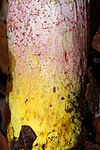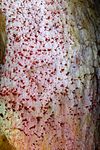| Harrya chromapes | |
|---|---|

| |
| Scientific classification | |
| Domain: | Eukaryota |
| Kingdom: | Fungi |
| Division: | Basidiomycota |
| Class: | Agaricomycetes |
| Order: | Boletales |
| Family: | Boletaceae |
| Genus: | Harrya |
| Species: | H. chromapes |
| Binomial name | |
| Harrya chromapes (Frost) Halling, Nuhn, Osmundson, & Manfr.Binder (2012) | |
| Synonyms | |
List
| |
| Harrya chromapes | |
|---|---|
| Pores on hymenium | |
| Cap is convex or flat | |
| Stipe is bare | |
| Spore print is pinkish-brown | |
| Ecology is mycorrhizal | |
| Edibility is edible | |
Harrya chromapes, commonly known as the yellowfoot bolete or the chrome-footed bolete, is a species of bolete fungus in the family Boletaceae. The bolete is found in eastern North America, Costa Rica, and eastern Asia, where it grows on the ground, in a mycorrhizal association with deciduous and coniferous trees. Fruit bodies have smooth, rose-pink caps that are initially convex before flattening out. The pores on the cap undersurface are white, aging to a pale pink as the spores mature. The thick stipe has fine pink or reddish dots (scabers), and is white to pinkish but with a bright yellow base. The mushrooms are edible but are popular with insects, and so they are often infested with maggots.
In its taxonomic history, Harrya chromapes has been shuffled to several different genera, including Boletus, Leccinum, and Tylopilus, and is known in field guides as a member of one of these genera. In 2012, it was transferred to the newly created genus Harrya when it was established that morphological and molecular evidence demonstrated its distinctness from the genera in which it had formerly been placed.
Taxonomy
The species was first described scientifically by American mycologist Charles Christopher Frost as Boletus chromapes. Cataloging the bolete fungi of New England, Frost published 22 new bolete species in that 1874 publication. Rolf Singer placed the species in Leccinum in 1947 due to the scabrous dots on the stipe, even though the spore print color was not typical of that genus. In 1968, Alexander H. Smith and Harry Delbert Thiers thought that Tylopilus was a more appropriate fit as they believed the pinkish-brown spore print—characteristic of that genus—to be of greater taxonomic significance. Other genera to which it has been shuffled in its taxonomic history include Ceriomyces by William Alphonso Murrill in 1909, and Krombholzia by Rolf Singer in 1942; Ceriomyces and Krombholzia have since been subsumed into Boletus and Leccinum, respectively. Additional synonyms include Tylopilus cartagoensis, described by Wolfe & Bougher in 1993, and a later combination based on this name, Leccinum cartagoense.
Molecular analysis of large-subunit ribosomal DNA and translation elongation factor 1α showed that the species belonged to a unique lineage in the family Boletaceae, and the genus Harrya was circumscribed to contain both it (as the type species) and the newly described H. atriceps. Javan species referred to Tylopilus pernanus are sister to the Harrya lineage.
The specific epithet chromapes is Latin for "yellow foot". It is commonly known as the "yellowfoot bolete" or the "chrome-footed bolete".
Description
 The stipe base is chrome yellow.
The stipe base is chrome yellow. The stipe surface has pink or reddish scabers.
The stipe surface has pink or reddish scabers.
The fruit bodies have caps that are initially convex before flattening out in maturity, reaching diameters between 3 and 15 cm (1.2 and 5.9 in). The cap surface is dry to slightly sticky. It is initially pink to rose-colored, fading to tan or pinkish tan in maturity. The cap margin may curl upward in maturity. The flesh is white, and does not stain blue when it is bruised or injured (an important diagnostic feature of many bolete species). It does not have any distinct odor or taste. The pore surface is initially white before becoming pinkish to flesh-colored in age. The individual pores are circular to angular, numbering two or three per millimeter, while the tubes are 8–14 mm (0.3–0.6 in) long. Tubes near the top of the stipe are depressed and almost free from attachment. The stipe measures 4–14 cm (1.6–5.5 in) long by 1–2.5 cm (0.4–1.0 in) thick and is equal in width throughout its length, or with a slight taper in either direction. The stipe surface has a scurfy texture from scabers that are colored white, pink or reddish. The underlying surface color is white or pinkish except for the yellow base. The mushrooms are edible and good, but popular with insects, and so are often infested with maggots.

The spore print has been reported as ranging in color from pinkish, to pinkish-brown, to rosy brown, to vinaceous-fawn. The variation in spore print color results in part from differences in moisture content when recorded. Spores are roughly oblong to oval, smooth, hyaline (translucent) to pale brown, and measure 11–17 by 4–5.5 μm. They are covered in a gelatinous sheath. The basidia (spore-bearing cells) are club-shaped, two- and four-spored, thin-walled, and measure 25–35 by 10–14 μm. Pleurocystidia (found on the tube walls) are roughly cylindrical to fuse-shaped with rounded tips, and measure 37–50 by 5–8 μm. Cheilocystidia (on the tube edges) are fuse-shaped with a central swelling, thin-walled, and measure 23–40 by 6–8 μm. Caulocystidia at the top of the stipe have various shapes and dimensions of 25–45 by 10–15 μm; at the stipe base, the caulocystidia are 30–40 by 7–23 μm and are mostly club-shaped to roughly spherical to tear-shaped. The cap cuticle comprises a single layer of tangled hyphae that are 4–6 μm thick.
Several chemical tests can be used to confirm the identify of the mushroom. A drop of ferrous sulfate (FeSO4) on the flesh turns it greenish, while potassium hydroxide (KOH) turns it brown. The cap cuticle turns yellow with nitric acid (HNO3), and yellow with ammonium hydroxide (NH4OH).
Similar species
Fruit bodies of Harrya chromapes are readily identified in the field by their rosy color, bright yellow stipe base, and reddish scabers on the stipe. Tylopilus subchromapes is a similar species found in Australia. Tylopilus ballouii has a more orangish cap and lacks the distinctive chrome-yellow stipe base. Harrya atriceps is a closely related rare species from Costa Rica. In contrast to its more common relative, it lacks reddish color in its stipe scabers and has a black cap, although it has a similar yellow stipe base.
Habitat and distribution
Harrya chromapes is an ectomycorrhizal species, and its fruit bodies grow singly to scattered on soil. They are usually found in forests containing conifers, Betulaceae and oak in North America. The North American distribution includes eastern Canada south to Georgia and Alabama, including Mexico. It extends west to Michigan and Mississippi. The fruit season extends from late spring to late summer. In Costa Rica, where the species associates with oak, it has been recorded from the Cordillera Talamanca, the Poás and Irazu Volcano. It is also in Guatemala. In Asia, it is known from India (West Bengal), Taiwan, Japan, and in China, where it associates with trees from the beech and pine families.
Fruit bodies can be parasitized by the molds Sepedonium ampullosporum, S. laevigatum, and S. chalcipori. In Sepedonium infections, a white to powdery yellow mold covers the surface of the fruit body. The mushrooms are a food source and rearing habitat for several insect species, including the fungus gnats Mycetophila fisherae and M. signatoides, and flies such as Pegomya winthemi and species of the genera Sciophila and Mydaea. The cottontail rabbit species Sylvilagus brasiliensis has been recorded feeding on the mushrooms in Costa Rica.
See also
References
- ^ Halling RE, Nuhn M, Osmundson T, Fechner N, Trappe JM, Soytong K, Arora D, Hibbett DS, Binder M (2012). "Affinities of the Boletus chromapes group to Royoungia and the description of two new genera, Harrya and Australopilus". Australian Systematic Botany. 25 (6): 418–31. doi:10.1071/SB12028. S2CID 86131274.
- Frost CC. (1874). "Catalogue of boleti of New England, with descriptions of new species". Bulletin of the Buffalo Society of Natural Sciences. 2: 100–5.
- Singer R. (1947). "The Boletoideae of Florida. The Boletineae of Florida with notes on extralimital species III". The American Midland Naturalist. 37 (1st ed.). Weinheim, Germany: Cramer: 1–135 (see p. 124).
{{cite journal}}: Cite journal requires|journal=(help) - Smith AH, Thiers HD (1968). "Notes on Boletes: 1. The generic position of Boletus subglabripes and Boletus chromapes 2. A comparison of four species of Tylopilus". Mycologia. 60 (4): 943–54. doi:10.2307/3757396. JSTOR 3757396.
- Murrill WA. (1909). "The Boletaceae of North America – 2". Mycologia. 1 (4): 140–60. doi:10.2307/3753125. JSTOR 3753125.
- Singer R. (1942). "Das System der Agaricales. II". Annales Mycologici (in German). 40 (1–2): 1–132 (seep. 34).
- Kirk PM, Cannon PF, Minter DW, Stalpers JA (2008). Dictionary of the Fungi (10th ed.). Wallingford, UK: CAB International. pp. 128, 355. ISBN 978-0-85199-826-8.
- ^ Wolfe CB, Bougher NL (1993). "Systematics, mycogeography, and evolutionary history of Tylopilus subg. Roseoscarbra in Australia elucidated by comparison with Asian and American species". Australian Systematic Botany. 6 (3): 187–213. doi:10.1071/SB9930187.
- Halling RE. (1999). "New Leccinum species from Costa Rica". Kew Bulletin. 54 (3): 747–53. doi:10.2307/4110871. JSTOR 4110871.
- Roberts P, Evans S (2011). The Book of Fungi. Chicago, Illinois: University of Chicago Press. p. 360. ISBN 978-0-226-72117-0.
- "English names for fungi 2013". British Mycological Society. June 2013. Archived from the original on 2015-09-23. Retrieved 2013-09-01.
- ^ Bessette AE, Roody WC, Bessette AR (2000). North American Boletes. Syracuse, New York: Syracuse University Press. pp. 9, 261–2. ISBN 978-0-8156-0588-1.
- ^ McKnight VB, McKnight KH (1987). A Field Guide to Mushrooms: North America. Peterson Field Guides. Boston, Massachusetts: Houghton Mifflin. p. 121. ISBN 978-0-395-91090-0.
- Groves C. (1979). Edible and Poisonous Mushroom of Canada. Ottawa, Canada: Research Branch, Agriculture Canada. p. 226. ISBN 9780660101361.
- Arora D. (1986). Mushrooms Demystified: A Comprehensive Guide to the Fleshy Fungi. Berkeley, California: Ten Speed Press. pp. 533–4. ISBN 978-0-89815-169-5.
- ^ Thiers HD, Smith AH (1971). The Boletes of Michigan. Ann Arbor: University of Michigan Press. pp. 92–3. ISBN 0-472-85590-5.
- ^ Grund DW, Harrison KA (1976). Nova Scotian Boletes. Bibliotheca Mycologia. Vol. 47. Lehre, Germany: J. Cramer. pp. 194–6. ISBN 978-3-7682-1062-1.
- Roody WC. (2003). Mushrooms of West Virginia and the Central Appalachians. Lexington, Kentucky: University Press of Kentucky. p. 339. ISBN 978-0-8131-9039-6.
- Villarreal L, Gomez A (1997). "Inventory and monitoring wild edible mushrooms in México". In Palm ME, Chapela IH (eds.). Mycology in Sustainable Development: Expanding Concepts, Vanishing Borders. Parkway Publishers. p. 104. ISBN 978-1-887905-01-5.
- Martínez-Carrera D, Curvetto N, Sobal P, Morales P, Mora VM (2010). Hacia un Desarrollo Sostenible del Sistema de Producción-Consumo de los Hongos Comestibles y Medicinales en Latinoamérica: Avances y Perspectivas en el Siglo XXI (in Spanish). Pueblo, Mexico: Red Latinoamericana de Hongos Comestibles y Medicinales. p. 459. ISBN 978-970-9752-01-4.
- De AB. (2006). "Two new additions to Indian Boletaceae". Journal of Natural History. 2 (1): 11–16. ISSN 0973-6166.
- Yeh K-W, Chen Z-C (1983). "Boletes of Taiwan 4". Taiwania. 28: 122–7. ISSN 0372-333X.
- Hongo T. (1980). "Tylopilus spp. of western Japan". Memoirs of the Faculty of Education Shihga University Natural Science (in Japanese) (30): 63–7. ISSN 0488-6291.
- Sahr T, Ammer H, Besl H, Fischer M (1999). "Infrageneric classification of the boleticolous genus Sepedonium: Species delimitation and phylogenetic relationships". Mycologia. 91 (6): 935–43. doi:10.2307/3761625. JSTOR 3761625.
- Bruns T. (1984). "Insect mycophagy in the Boletales: Fungivore diversity and the mushroom habitat". In Wheeler Q, Blackwell M (eds.). Fungus-Insect Relationships: Perspectives in Ecology and Evolution. New York: Columbia University Press. pp. 91–129. ISBN 978-0-231-05694-6.
- Wainwright M, Arias O (2007). The Mammals of Costa Rica: A Natural History and Field Guide. Comstock. p. 239. ISBN 978-0-8014-4589-7.
External links
| Taxon identifiers | |
|---|---|
| Harrya chromapes | |
| Boletus chromipes | |